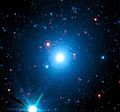NGC 1404
Coordinates:  03h 38m 51.917s, −35° 35′ 39.81″
03h 38m 51.917s, −35° 35′ 39.81″
| NGC 1404 | |
|---|---|
J2000 epoch) | |
| Constellation | Eridanus |
| Right ascension | 03h 38m 51.917s[1] |
| Declination | −35° 35′ 39.81″[1] |
| Redshift | 0.006498[2] |
| Heliocentric radial velocity | 1942 ± 48 km/s[2] |
| Distance | 61 Mly (18.7 Mpc)[3] |
| Apparent magnitude (V) | 10.00[4] |
| Apparent magnitude (B) | 10.97[4] |
| Characteristics | |
| Type | E1[4] |
| Apparent size (V) | 3.3′ × 3.0′[4] |
| Other designations | |
| MCG -06-09-013, PGC 13433[2] | |
NGC 1404 is an elliptical galaxy in the Southern constellation Eridanus. It was discovered on November 28, 1837, by the astronomer John Herschel.[5] Based on the tip of the red-giant branch distance indicator, it lies at a distance of approximately 60 million light-years from the Milky Way.[3] It is one of the brightest members of the Fornax Cluster.[6][7]
Characteristics
As usual with most elliptical galaxies, NGC 1404 is rich in globular clusters, with a population of them that has been estimated to be around 725;[8] however it has been proposed it could have lost most of its globular clusters due to gravitational interactions with NGC 1399, the brightest galaxy of the Fornax Cluster.[9]
Studies using the
ram-pressure stripping caused by the motion of NGC 1404 through Fornax' intracluster medium is stripping the galaxy of its hot gas,[10] leaving behind a large trail.[11]
Gallery
-
False-color image of NGC 1404 taken by the Spitzer Space Telescope
References
- ^ S2CID 18913331.
- ^ a b c "NGC 1404". SIMBAD. Centre de données astronomiques de Strasbourg. Retrieved 2021-02-21.
- ^ S2CID 231728270.
- ^ S2CID 119085482.
- ^ Seligman, Courtney. "New General Catalogue objects: NGC 1400 - 1449". cseligman.com. Retrieved 2021-02-21.
- ^ "Falling in Fornax". www.eso.org. Retrieved 28 October 2019.
- S2CID 16521293.
- S2CID 119362742.
- S2CID 16549156.
- S2CID 14902493.
- ^ http://chandra.harvard.edu/photo/2004/fornax/ Fornax Cluster: Motions of Nearby Galaxy Cluster Reveal Presence of Hidden Superstructure
External links
 Media related to NGC 1404 at Wikimedia Commons
Media related to NGC 1404 at Wikimedia Commons

